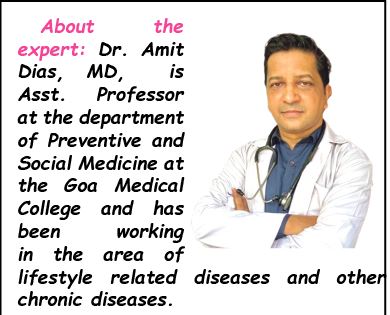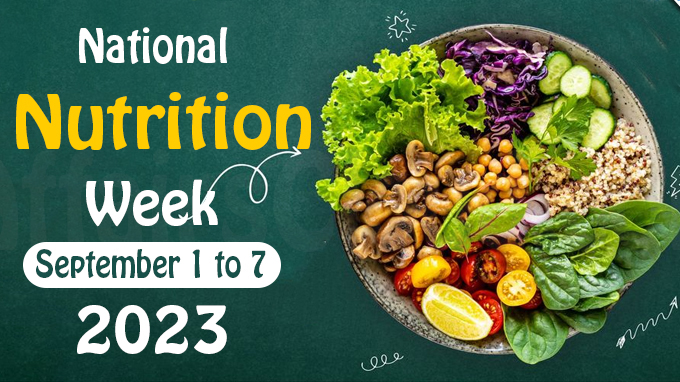The first week of September is observed as the National Nutrition Week. This week Goan Observer asked DR AMIT DIAS from the Department of Preventive & Social Medicine to understand the theme for this year: “Healthy Diet: Affordable to all.” He says, “Millets are small but MIGHTY, they are both healthy and affordable.” He throws more light on millets in this informative interview….
GOAN OBSERVER: Why do we need to observe Nutrition Week?
DR AMIT DIAS: Lifestyles are changing for the better and so is the quality of our food, at least in the better off sections of society. According to a report by the Food & Agriculture Organisation in India, around 190 million people suffer basically from lack of adequate nutrition in India and in consequent the health problems which arise due to lack of good nutritional inputs in their eating habits. The World Health Organisation (WHO) estimates that 40% of children and 37% of pregnant women worldwide are anemic.
Globally 1.9 billion people are overweight or obese. Nutritional problems range from under-nutrition or over-nutrition which relate to specific deficiencies in minerals and vitamins. This is particularly true in developed states such as ours. The recent INDIAB study conducted by us in Goa revealed that we have the highest prevalence of diabetes in the country with 26.4% above the age of 20 years. Most of these problems are preventable.
Nutrition Week is observed in the first week of September since 1982, to get people to understand the value of a balanced diet and lifestyle. Good food is within our reach and can be affordable. We need to make use of this opportunity to motivate people to change their bad habits in favor of better habits regarding healthier eating and lifestyles.
Q: The theme for Nutrition Week this year is “Healthy Diet: Affordable to All.” How do you think this can happen?
A: The theme fits in very well with the UN consensus resolution adopted earlier this year when 2023 was declared the International Year of Millets. Millets are small grains but packed with nutrients which are mighty. They are affordable and fit in very well with the theme for our Nutrition Awareness Week this year. We are also noticing what is referred to as “hidden hunger”…which refers to a deficiency of micronutrients such as calcium, iron, zinc, iodine, etc – in people who otherwise appear fine but only superficially so.
Q: Doctor for the benefit of all can you explain what are millets? People are often familiar with the word but do not know what they are.
A: Millets are a group of small, round whole-grain cereals. They are not only nutritious but also drought and pest-resistant and therefore encouraged to bridge the nutrition gap in medical parlance.
Q:What is the nutritional value of millets?
A: Millets are packed with nutrients. Notably, they contain a wide range of vitamins and minerals. They contain slightly higher amounts of amino acids than cereals. Millet like ragi contains a high amount of calcium… 100 gm of ragi (finger millet), also known as nachini, will give around 344 mg of calcium which is good for our bones and is an ideal supplement for pregnant and lactating women and also elders. In general, 100 gm of millets contain the following.
Here are various nutritional components and values of cooked millet of 100 g.
Carbohydrate – 23 g, Protein – 4 g, Dietary fiber – 1.3 g, Manganese – 0.272 mg, Magnesium – 44 mg, Phosphorus – 100 mg. It will also give around 336 kilocalories of energy. It has a lower glycemic index, which means that the sugar rise in your blood will be slower as compared to rice or bread, but remember that it does contribute to the calories and though healthy, must be eaten in moderation by those who have dietary restrictions. They are gluten-free.
Q: What are the different types of millet?
A: Honestly, I started to research more about millets after the UN resolution. You will be surprised to know that there are over 20 varieties of millets we are familiar with, here are the common ones and their benefits.
Finger Millet (Ragi): It’s utilized as a healthier choice than rice and wheat cereals and is commonly consumed as a major part of the meal in some of the southern states. “Tizaan, ambil, satva” are commonly made dishes, but there are plenty of other options too. Ragi has multiple benefits. It’s rich in calcium and iron as mentioned earlier, but it also contributes to cognitive development.
Foxtail Millet (Kangni/ Kakum): It contains healthy carbohydrates that assist in regulating blood sugar. Its iron and calcium content also helps to strengthen immunity. Foxtail millet helps in the regulation of blood cholesterol and the increase of HDL — good cholesterol in levels in the body.
Pearl Millet (Bajra): Has been a culinary staple for many years and is becoming popular due to its nutritive value. It contains calcium and magnesium, protein, fiber, and iron. Better for diabetics compared to rice.
Buckwheat (Kuttu): This millet helps in weight reduction and is good for the heart. It can prevent diseases such as cholelithiasis and breast cancer.
Little Millet (Kutki, Sama): This also helps in weight reduction. It’s a millet which very easily replace rice and is a more nutritious choice. It is full of fiber and contains a variety of mineral resources such as zinc, potassium, iron, and calcium. It also contains vitamin B, which offers nutritional value to your health and acts as an antioxidant with benefits in the prevention of cancer, and heart disease.
Q. What is your advice for our readers?
A: Everyone needs a nutritious balanced diet. Your food can help prevent several non-communicable diseases that are on the rise. Increase the fiber in the diet, decrease the sugars and salt, increase the servings of fruit and vegetables, and eat your staple diet most of the time as your system has adapted to it.
At the same time, we have to understand that it is not only about us. There are around 3 billion people who cannot afford a healthy meal and we need to work towards making food available to them as well. Let’s work on this together!

